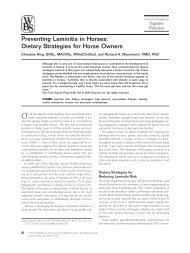Nutritional Secondary Hyperparathyroidism in the Horse
Nutritional Secondary Hyperparathyroidism in the Horse
Nutritional Secondary Hyperparathyroidism in the Horse
Create successful ePaper yourself
Turn your PDF publications into a flip-book with our unique Google optimized e-Paper software.
The Skeleton 83<br />
ary hyperparathyroidism <strong>in</strong> <strong>the</strong> dog [WEBER (1929)] and <strong>in</strong> sw<strong>in</strong>e<br />
[M~CSY (1959) ; COHRS (1961)l aga<strong>in</strong> exemplifies hyperostotic osteitis<br />
fibrosa. In <strong>the</strong>se two species <strong>the</strong> condition has been reproduced experimentally.<br />
WEBER and BECK (1932) <strong>in</strong>duced J'ch;rziffehankheit <strong>in</strong> young<br />
dogs <strong>in</strong> 9 to 12 weeks. The dietary calcium to phosphorus ratio was not<br />
given; <strong>the</strong> bone lesions were hyperostotic. LIEGEOIS and DERIVAUX<br />
(1951) fed young pigs diets with calcium to phosphorus ratios vary<strong>in</strong>g<br />
from 1 : 5.5 to 1 : 11.6. Lameness occurred with<strong>in</strong> 3 weeks, and at <strong>the</strong><br />
end of <strong>the</strong> seventh week <strong>the</strong> maxillary swell<strong>in</strong>g was severe enough to<br />
cause respiratory difficulties. Monkeys likewise are prone to develop<br />
hyperostotic generalized osteitis fibrosa, even with a moderately upset<br />
calcium to phosphorus balance <strong>in</strong> <strong>the</strong> feed [CORDY (1957); KROOIC and<br />
BARRETT (1962)l. In <strong>the</strong> horse <strong>the</strong> lesions develop relatively slowly and<br />
are usually hyperostotic (Chapter 11) but may be isostotic (this study).<br />
In cattle <strong>the</strong>y are usually isostotic [TAMAGAWA (1956)l.<br />
The reasons for such species differences may be sought <strong>in</strong> differences<br />
<strong>in</strong> <strong>the</strong> normal growth rate (Table XXII).<br />
In our study cl<strong>in</strong>ical symptoms of general osteitis fibrosa occurred<br />
as early as after 12 weeks. Us<strong>in</strong>g a similar calcium to phosphorus<br />
imbalance <strong>in</strong> <strong>the</strong> diet, CRAWFORD and STURGESS (1927) recorded<br />
cl<strong>in</strong>ical symptoms only after 9 months. The explanation appears to be<br />
<strong>the</strong> age factor: our horses were about one-half year old at <strong>the</strong> beg<strong>in</strong>n<strong>in</strong>g<br />
of <strong>the</strong> experiment; those of CRAWFORD and STURGESS were over 4<br />
years of age. In <strong>the</strong> experiments by NIIMI (1927) and by NIIMI and<br />
AOKI (1927) <strong>in</strong> which a 1 : 8.1 calcium to phosphorus ratio was used,<br />
<strong>the</strong> high age of <strong>the</strong> horses seems to be <strong>the</strong> explanation for <strong>the</strong> late<br />
occurrence of <strong>the</strong> cl<strong>in</strong>ical symptoms, viz., at 5 months.<br />
The explanation for <strong>the</strong> isostotic or slightly hyperostotic osteitis<br />
fibrosa <strong>in</strong> our NSH horses, <strong>in</strong> contrast to <strong>the</strong> marked hyperostotic rype<br />
reported <strong>in</strong> o<strong>the</strong>r spontaneous and experimental series appears aga<strong>in</strong><br />
to be <strong>the</strong> age factor. A less severe calcium to phosphorus imbalance <strong>in</strong><br />
<strong>the</strong> feed of young horses with a normally high metabolic rate would<br />
cause a more severe resorption than a more severe imbalance <strong>in</strong> adult<br />
horses with a relatively low metabolic rate <strong>in</strong> <strong>the</strong> skeleton.<br />
The cl<strong>in</strong>ical picture was dom<strong>in</strong>ated by lameness. Several authors<br />
[VARNELL (1 860) ; LANE (1906); ICINTNER and HOLT (1932); GREENLEE<br />
(1939); among o<strong>the</strong>rs] have described jo<strong>in</strong>t changes which would<br />
expla<strong>in</strong> <strong>the</strong> lameness. Because of resorption of trabeculae support<strong>in</strong>g<br />
<strong>the</strong> articular cartilage, this cartilage loses its support and yields to<br />
pressure. VARNELL also described subchondral cysts. Cartilage irregu-<br />
8 Krook/Lowe<br />
Downloaded from<br />
vet.sagepub.com by guest on April 14, 2010



